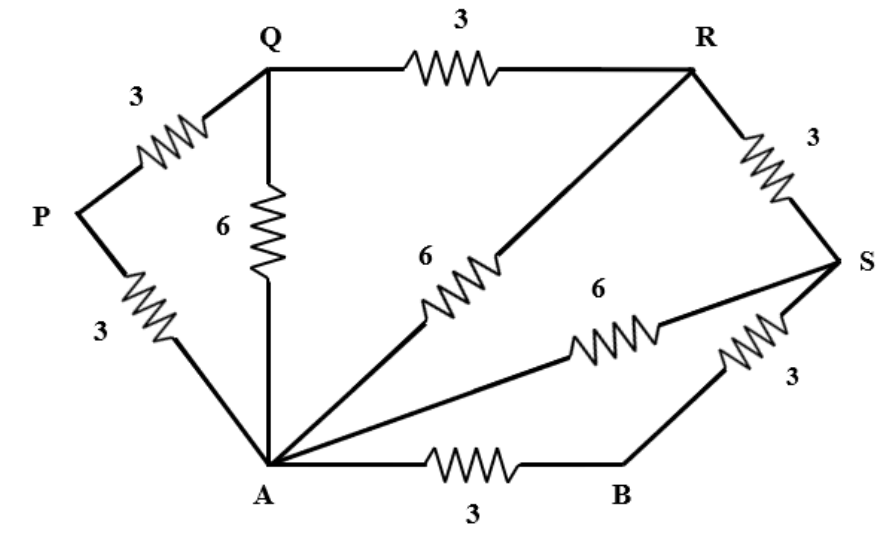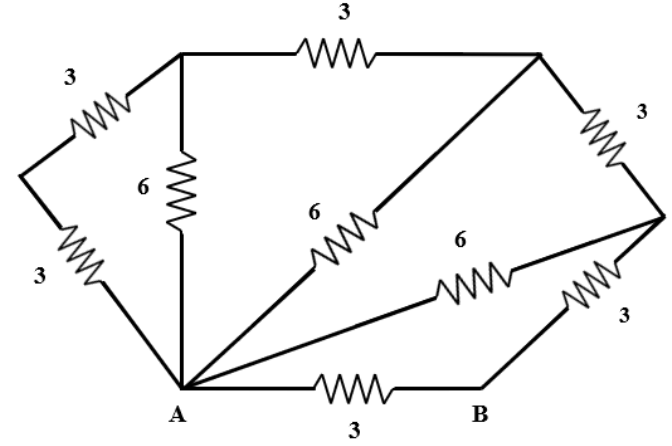
Answer
454.2k+ views
Hint: To solve this problem, use the formula for equivalent resistance when resistors are connected in series and also the formula for equivalent resistance when resistors are connected in parallel. Find the equivalent resistance of the first network then combine it with resistance of another network. Find the equivalent resistance of both the networks combined. Similarly, find the equivalent resistance of each network and find the effective resistance between points A and B.
Formula used:
$ \dfrac {1}{{R}_{eq}}= \dfrac {1} {{R}_{1}} + \dfrac {1}{{R}_{2}}+ \dfrac {1}{{R}_{3}}+ …+\dfrac {1}{{R}_{N}}$
${R}_{eq}= {R}_{1}+{R}_{2}+{R}_{3}+…+{R}_{N}$
Complete step-by-step solution:

In the above labelled diagram, we can see the resistors AP and PQ are in series. So, their equivalent resistance will be,
${R}_{eq1}= 3 + 3$
$\Rightarrow {R}_{eq1}= 6\Omega$
Now, the ${R}_{eq1}$ connected in parallel with the resistor AQ. So, their equivalent resistance is given by,
$\dfrac {1}{{R}_{eq2}}= \dfrac {1}{{R}_{eq1}}+ \dfrac {1}{{R}_{AQ}}$
Substituting values in above equation we get,
$\dfrac {1}{{R}_{eq2}}= \dfrac {1}{6}+ \dfrac {1}{6}$
$\Rightarrow \dfrac {1}{{R}_{eq2}}=\dfrac {12}{36}$
$\Rightarrow {R}_{eq2}= \dfrac {36}{12}$
$\Rightarrow {R}_{eq2}= 3\Omega$
Now, ${R}_{eq2}$ is in series with the resistor QR. So, their equivalent resistance is given by,
${R}_{eq3}= {R}_{eq2}+ {R}_{QR}$
Substituting the values in above equation we get,
${R}_{eq3}= 3 + 3$
$\Rightarrow {R}_{eq3}= 6\Omega$
Now, the ${R}_{eq3}$ connected in parallel with the resistor AR. So, their equivalent resistance is given by,
$\dfrac {1}{{R}_{eq4}}= \dfrac {1}{{R}_{eq3}}+ \dfrac {1}{{R}_{AR}}$
Substituting values in above equation we get,
$\dfrac {1}{{R}_{eq4}}= \dfrac {1}{6}+ \dfrac {1}{6}$
$\Rightarrow \dfrac {1}{{R}_{eq4}}=\dfrac {12}{36}$
$\Rightarrow {R}_{eq4}= \dfrac {36}{12}$
$\Rightarrow {R}_{eq4}= 3\Omega$
Now, ${R}_{eq4}$ is in series with the resistor RS. So, their equivalent resistance is given by,
${R}_{eq5}= {R}_{eq4}+ {R}_{RS}$
Substituting the values in above equation we get,
${R}_{eq5}= 3 + 3$
$\Rightarrow {R}_{eq5}= 6\Omega$
Now, the ${R}_{eq5}$ connected in parallel with the resistor AS. So, their equivalent resistance is given by,
$\dfrac {1}{{R}_{eq6}}= \dfrac {1}{{R}_{eq5}}+ \dfrac {1}{{R}_{AS}}$
Substituting values in above equation we get,
$\dfrac {1}{{R}_{eq6}}= \dfrac {1}{6}+ \dfrac {1}{6}$
$\Rightarrow \dfrac {1}{{R}_{eq6}}=\dfrac {12}{36}$
$\Rightarrow {R}_{eq6}= \dfrac {36}{12}$
$\Rightarrow {R}_{eq6}= 3\Omega$
Now, ${R}_{eq6}$ is in series with the resistor SB. So, their equivalent resistance is given by,
${R}_{eq7}= {R}_{eq6}+ {R}_{SB}$
Substituting the values in above equation we get,
${R}_{eq7}= 3 + 3$
$\Rightarrow {R}_{eq7}= 6\Omega$
Now, the ${R}_{eq7}$ connected in parallel with the resistor AB. So, their equivalent resistance is given by,
$\dfrac {1}{{R}_{eq8}}= \dfrac {1}{{R}_{eq7}}+ \dfrac {1}{{R}_{AB}}$
Substituting values in above equation we get,
$\dfrac {1}{{R}_{eq8}}= \dfrac {1}{6}+ \dfrac {1}{3}$
$\Rightarrow \dfrac {1}{{R}_{eq8}}=\dfrac {9}{18}$
$\Rightarrow {R}_{eq8}= \dfrac {18}{9}$
$\Rightarrow {R}_{eq8}= 2\Omega$
Hence, the effective resistance between points A and B is 2 ohms. So, the correct answer is option D i.e. 2 ohms.
Note: Students should remember that the equivalent resistance of a combination is always less than the smallest resistance in the parallel network. As we add more resistors in the network, the total resistance of the circuit will always decrease. While, in a series network, the equivalent resistance of the network is greater than the value of the largest resistor in the chain. The current flowing through each parallel branch may not be the same. But the voltage across each resistor in a parallel network is always the same.
Formula used:
$ \dfrac {1}{{R}_{eq}}= \dfrac {1} {{R}_{1}} + \dfrac {1}{{R}_{2}}+ \dfrac {1}{{R}_{3}}+ …+\dfrac {1}{{R}_{N}}$
${R}_{eq}= {R}_{1}+{R}_{2}+{R}_{3}+…+{R}_{N}$
Complete step-by-step solution:

In the above labelled diagram, we can see the resistors AP and PQ are in series. So, their equivalent resistance will be,
${R}_{eq1}= 3 + 3$
$\Rightarrow {R}_{eq1}= 6\Omega$
Now, the ${R}_{eq1}$ connected in parallel with the resistor AQ. So, their equivalent resistance is given by,
$\dfrac {1}{{R}_{eq2}}= \dfrac {1}{{R}_{eq1}}+ \dfrac {1}{{R}_{AQ}}$
Substituting values in above equation we get,
$\dfrac {1}{{R}_{eq2}}= \dfrac {1}{6}+ \dfrac {1}{6}$
$\Rightarrow \dfrac {1}{{R}_{eq2}}=\dfrac {12}{36}$
$\Rightarrow {R}_{eq2}= \dfrac {36}{12}$
$\Rightarrow {R}_{eq2}= 3\Omega$
Now, ${R}_{eq2}$ is in series with the resistor QR. So, their equivalent resistance is given by,
${R}_{eq3}= {R}_{eq2}+ {R}_{QR}$
Substituting the values in above equation we get,
${R}_{eq3}= 3 + 3$
$\Rightarrow {R}_{eq3}= 6\Omega$
Now, the ${R}_{eq3}$ connected in parallel with the resistor AR. So, their equivalent resistance is given by,
$\dfrac {1}{{R}_{eq4}}= \dfrac {1}{{R}_{eq3}}+ \dfrac {1}{{R}_{AR}}$
Substituting values in above equation we get,
$\dfrac {1}{{R}_{eq4}}= \dfrac {1}{6}+ \dfrac {1}{6}$
$\Rightarrow \dfrac {1}{{R}_{eq4}}=\dfrac {12}{36}$
$\Rightarrow {R}_{eq4}= \dfrac {36}{12}$
$\Rightarrow {R}_{eq4}= 3\Omega$
Now, ${R}_{eq4}$ is in series with the resistor RS. So, their equivalent resistance is given by,
${R}_{eq5}= {R}_{eq4}+ {R}_{RS}$
Substituting the values in above equation we get,
${R}_{eq5}= 3 + 3$
$\Rightarrow {R}_{eq5}= 6\Omega$
Now, the ${R}_{eq5}$ connected in parallel with the resistor AS. So, their equivalent resistance is given by,
$\dfrac {1}{{R}_{eq6}}= \dfrac {1}{{R}_{eq5}}+ \dfrac {1}{{R}_{AS}}$
Substituting values in above equation we get,
$\dfrac {1}{{R}_{eq6}}= \dfrac {1}{6}+ \dfrac {1}{6}$
$\Rightarrow \dfrac {1}{{R}_{eq6}}=\dfrac {12}{36}$
$\Rightarrow {R}_{eq6}= \dfrac {36}{12}$
$\Rightarrow {R}_{eq6}= 3\Omega$
Now, ${R}_{eq6}$ is in series with the resistor SB. So, their equivalent resistance is given by,
${R}_{eq7}= {R}_{eq6}+ {R}_{SB}$
Substituting the values in above equation we get,
${R}_{eq7}= 3 + 3$
$\Rightarrow {R}_{eq7}= 6\Omega$
Now, the ${R}_{eq7}$ connected in parallel with the resistor AB. So, their equivalent resistance is given by,
$\dfrac {1}{{R}_{eq8}}= \dfrac {1}{{R}_{eq7}}+ \dfrac {1}{{R}_{AB}}$
Substituting values in above equation we get,
$\dfrac {1}{{R}_{eq8}}= \dfrac {1}{6}+ \dfrac {1}{3}$
$\Rightarrow \dfrac {1}{{R}_{eq8}}=\dfrac {9}{18}$
$\Rightarrow {R}_{eq8}= \dfrac {18}{9}$
$\Rightarrow {R}_{eq8}= 2\Omega$
Hence, the effective resistance between points A and B is 2 ohms. So, the correct answer is option D i.e. 2 ohms.
Note: Students should remember that the equivalent resistance of a combination is always less than the smallest resistance in the parallel network. As we add more resistors in the network, the total resistance of the circuit will always decrease. While, in a series network, the equivalent resistance of the network is greater than the value of the largest resistor in the chain. The current flowing through each parallel branch may not be the same. But the voltage across each resistor in a parallel network is always the same.
Recently Updated Pages
10 Examples of Evaporation in Daily Life with Explanations

10 Examples of Diffusion in Everyday Life

1 g of dry green algae absorb 47 times 10 3 moles of class 11 chemistry CBSE

What is the meaning of celestial class 10 social science CBSE

What causes groundwater depletion How can it be re class 10 chemistry CBSE

Under which different types can the following changes class 10 physics CBSE

Trending doubts
Fill the blanks with the suitable prepositions 1 The class 9 english CBSE

Which are the Top 10 Largest Countries of the World?

How do you graph the function fx 4x class 9 maths CBSE

Distinguish between the following Ferrous and nonferrous class 9 social science CBSE

The term ISWM refers to A Integrated Solid Waste Machine class 10 social science CBSE

The Equation xxx + 2 is Satisfied when x is Equal to Class 10 Maths

Difference between Prokaryotic cell and Eukaryotic class 11 biology CBSE

Which is the longest day and shortest night in the class 11 sst CBSE

In a democracy the final decisionmaking power rests class 11 social science CBSE





